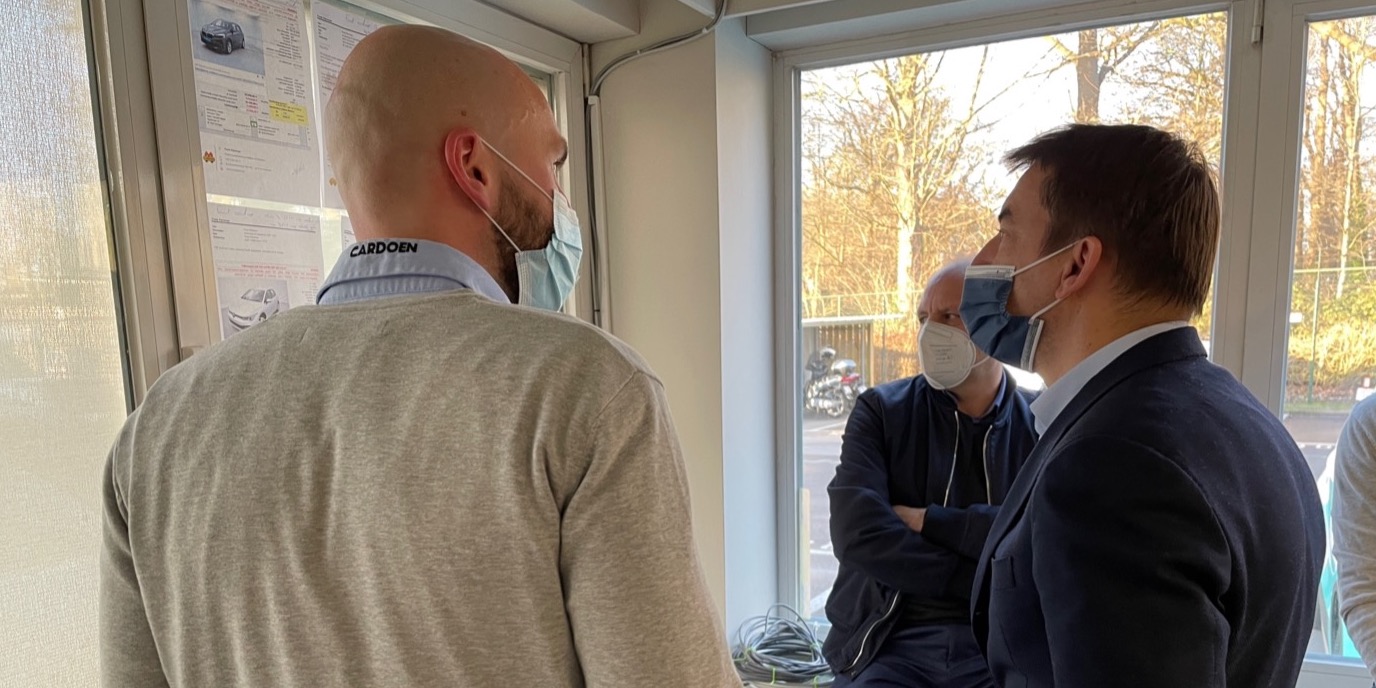
How to spread lean principles without hindering results
CASE STUDY - What does having a new “true north” mean? Following the merger with a large group, cancer center IOV is looking to seamlessly spread its lean management system to new operations and facilities.
Words: Flávio Battaglia, Director, Lean Institute Brasil
Since adopting lean tools and principles in 2008, Instituto de Oncologia do Vale has achieved impressive results year after year and gradually reshaped its way of doing things. The center is one of the pioneers in applying lean in healthcare in Brazil, and probably the best example.
Throughout the journey, the role of CEO Carlos Frederico Pinto (we call him Dr Fred) was critical.
Dr Fred, an oncologist, is the person who turned the first lean ideas into actions and kept the improvement spirit alive over the years, using an approach similar to the one Dr Sami Bahri describes in his book Follow the Learner.
Dr Fred took on the challenge of transforming the organization, and he did, by going to the front line himself, learning by doing and leading by example. In a small organization, his followers knew he, the learner, was always around to provide support.
But a change in circumstances can shake the foundations of any organization, no matter how lean.
In September 2013, IOV announced its merger with a big Brazilian healthcare group.
The organization is now in charge of spreading its management system to new facilities, without disrupting the performance of existing processes and improvement efforts. It basically has a new True North. Lean Institute Brasil was invited to be part of the problem solving team, and here is how we are facing the issue.

A NEW TRUE NORTH
As part of the merger agreement, the IOV team now manages all outpatient cancer treatment services for the region. Three new facilities were absorbed in a short period of time. This means it will be necessary to spread the organization’s successful lean management system to the new facilities, without disrupting existing processes and keeping improvement efforts alive.
Recognizing that this abrupt growth could create problems and scatter key technical and managerial competencies, the IOV leadership team decided to apply major changes to the organization’s structure and to tackle resource utilization.
The old business structure was no longer appropriate; some resources were overloaded; others might no longer be needed on their current positions; a lot of redundant back office activity could be eliminated.
The new direction, essentially a new “true north”, would require a new type of organization, one that is able to connect purpose, process and people in a fast-growing environment. The role of Dr Fred and other senior executives had to be gradually rethought.
As mentioned before, Dr Fred has always played a central role in promoting and experimenting with lean ideas. And, of course, his word really counts at IOV. His gemba approach created an environment of openness and discussion, so he was always aware of every problem solving, lean, or accreditation initiative that was taking place.
A team was formed that includes the executive committee (Dr Fred and two directors), the management team (four managers and four supervisors), the lean promotion office (two project managers), and one external consultant (myself, from Lean Institute Brasil).
Dr Fred and IOV have been great partners of Lean Institute Brasil for a few years: they open their doors to our public workshops, they always participate in our events, and they buy our books. But up until last fall we had never had the opportunity to work together to develop something new. That’s why we feel honored for being part of the team in charge of rethinking the organization for the next few years.
LIB was invited to be part of the problem solving team in charge of realigning people’s efforts, considering the new “true north” and its implications for the entire organization.
The project followed A3 thinking as a general framework and hoshin kanri principles. A “mother A3,” briefly summarized below, was connected to six other “baby A3s”, to be developed in the period from 2014 through to 2016.

The action plan was designed around four work meetings, from September to November 2013.
The first meeting was dedicated to communicating the purpose of our efforts, the methods we would use, the roles and responsibilities, and the expected deliverables. We also worked on problem definition and the information that would be required to clearly understand the current situation.
During the second meeting, 15 days later, we agreed on the consolidated current situation, specified the objectives and defined the critical factors to succeed.
The third meeting took place 10 days later, and was dedicated to developing and evaluating possible countermeasures and initiatives.
During the fourth meeting, which took place after a couple of weeks, critical decisions were made around the selected countermeasures.
DEFINING THE PROBLEM
It didn’t take too long for the group to grasp the situation. There was a new True North to aim for and if IOV were to get there, it would be necessary to realign people, efforts and processes. The new reality would call for a new organization, capable of dealing with new managerial needs, a different size/scale of the organization, new people and customers, different cultures, new suppliers, new buildings, new IT systems. All of this was combined with the already existing problems and challenges that the center was experiencing.
The strategic needs were defined as:
- Effectively co-operating with a big new partner, immediately absorbing three new clinics and merging back office operations (eliminating redundant activities);
- Expanding the (lean) management system to new facilities (increasing capacity);
- Keeping safety and quality at the highest levels (expansion could not increase risks for patients);
- Rethinking the management system to cope with a new reality (purpose, processes and people).
Growth meant more problems would need to be addressed. In this case, solving them would effectively translate into “minimizing growing pains”.
The challenge of understanding the current situation was to identify what we should focus on at first. By dividing the “big problem” into smaller and simpler ones, we could clearly see “where” the critical issues were.
The issues we gave priority to were:
- Stability
What is stable must be kept stable, but there are difficulties connected to sustaining this condition, with knowledge being spread around several facilities (a good thing because more people will be exposed to lean thinking, but potentially dangerous because of the risk of diluting the learning); additionally, expansion can neither increase risks for patients nor eliminate the harmonious working environment IOV was able to create for its employees. Strategic projects should be kept in place and delivered on time, but this is hard to achieve and to sustain as there are several difficulties in managing the existing projects/A3.
- People engagement
Front line staff seems to be more reluctant than before, focusing only on daily activities rather than engaging in problem solving and kaizen; this appears to be a symptom of the real problems (as experienced in one specific location within the newly created group). The lean promotion office, in turn, is not able to “make things happen” and people depend too much on experts.
- “Old structure” thinking
There are a number of problems related to communication; in particular, it is increasingly difficult to clarify hierarchical relations (in other words, the perception is that there are “too many bosses”, and authority and responsibilities are not clear) and silo thinking is proving difficult to eradicate. Finally, a few critical resources are overloaded, while others are idle, waiting for things to happen.
- Expansion I – clinical/technical issues (new services/patients)
There are substantial quality gaps in the services provided by the different clinics within the newly formed group: for each of them, the management system, culture and patient journey are completely different.
- Expansion II - back office issues (consolidating support areas/process)
While there are great opportunities for eliminating unnecessary activities in some of the clinics (such as purchasing, accounting, marketing, IT, HR), there is no clarity on what should be standardized and consolidated and what should remain separate.
The next step would be defining a specific goal, the things we have to achieve in a set period of time (2014 to 2016) in order to support the strategy and reach our new True North.
CRITICAL FACTORS
The next steps and the timelines to take them were set:
- Maintaining/boosting performance levels of existing operations, without increasing risks for patients and overloading staff (a permanent objective, tracked by current KPIs);
- Re-engaging people and encouraging front line workers to go back to contributing to the improvement process in one specific location (30 days to implement, but permanent monitoring);
- Re-thinking the role of the lean promotion office, creating a pull system (30 days to implement, but permanent monitoring);
- Rethinking the management structure to cope with the new reality (80 days to define + 30 days to implement);
- Incorporating new facilities and consolidating back office (120 days to implement).
A new business structure was needed. After a few discussions, the team agreed on the appointment of a manager for each value stream, both the existing and the newly incorporated ones.
This horizontal perspective, which follows the patient’s journey, suddenly appeared to be the missing piece of the puzzle: a manager for each value stream could create the kind of integration that was needed to improve the journey of the patient, eliminate communication barriers and offer the kind of accountability IOV was looking for.
The value stream manager would be responsible for the flow of patients, from the beginning to the end of the process. This, we all knew, would require a lot of movement of equipment and people. Dr Fred and his team, well versed in value stream management, reflected on the problem and saw this as the potential solution.
It soon became clear that the personal involvement of Dr Fred would be a critical success factor in the move towards a new management system that incorporates the new, very different organizations.
Dr Fred took the initiative, promoting the first value stream mapping exercise and daily teaching, to try to replicate the successful approach he had implemented in the “old” IOV.
A NEW WAY OF PLANNING
In order to achieve the objectives outlined above, two main decisions oriented towards a new way of planning for the next two years were made.
The first one is to update the structure of the organization to incorporate the value stream manager as the core figure for solving problems, developing people and connecting the steps to improve the patient’s journey.
The second one is the creation of six baby A3s, to detail the plans for 2014.
They include: one for each value stream, one for consolidating the back office activities, and one for the changes needed in the lean promotion office.
Each A3 will be created and owned by a value stream manager.
During the fourth meeting of the team, we began to draft the baby A3s, focusing on each value stream that we had identified. The new managers are excited about their new challenge and some of them have already started to take practical steps (despite my constant reminder: “We are just planning, let’s build the A3s first.”)
This article is also available in Portuguese - click here
Read more


FEATURE – For this new monthly article, we will be asking five lean practitioners the same question and share their answers with you. We started by asking them about their biggest lean mistake.


COLUMN – As lean teaches us, a command-and-control approach to management is bound to fail. What we need instead is trust in people, and decentralization of knowledge.


FEATURE – Lean Thinking is about voluntary participation, not audits that are meant to ensure compliance. The authors explore the advantages of pursuing cooperation rather than control.


INTERVIEW - New York City's public hospitals system leveraged lean principles and techniques to improve the quality of care and boost organizational performance.

